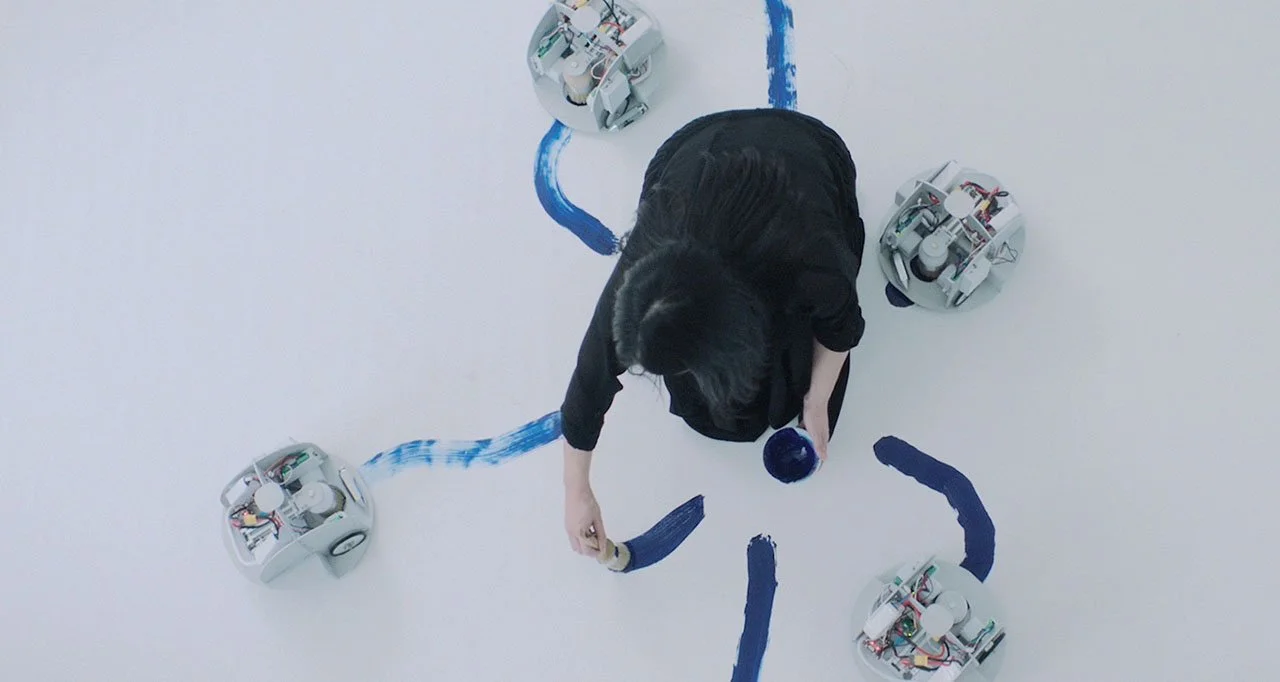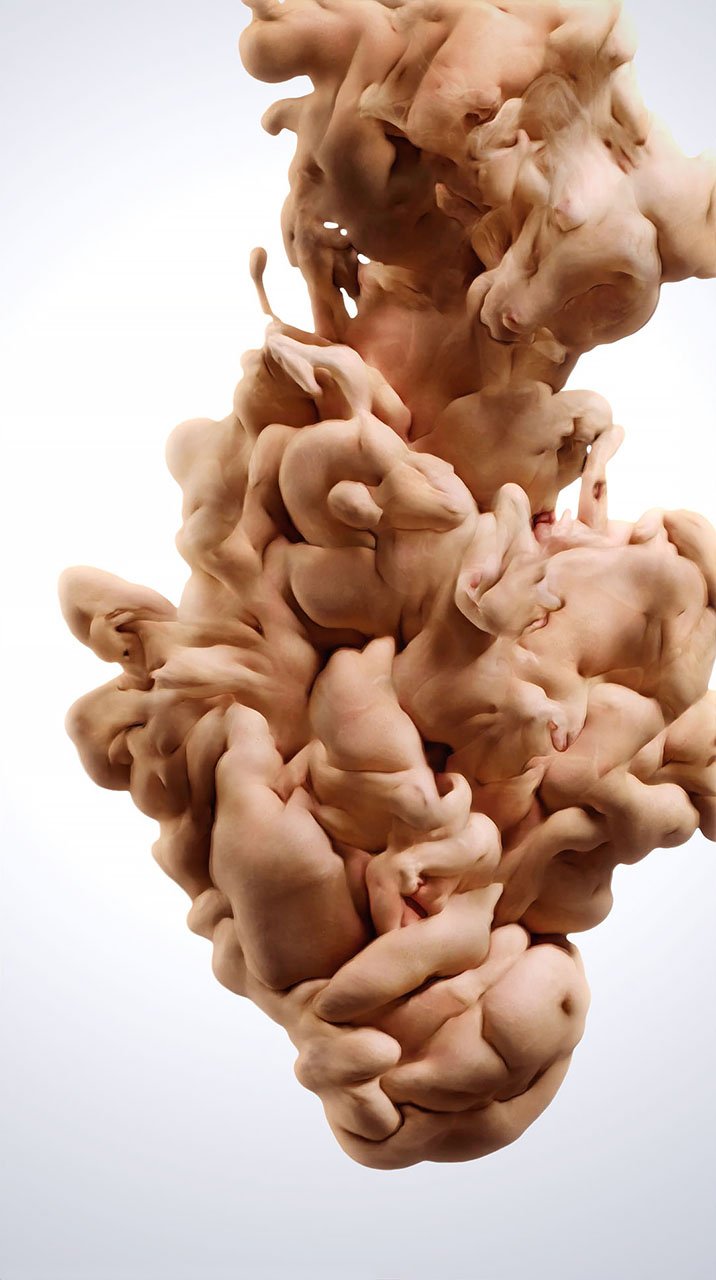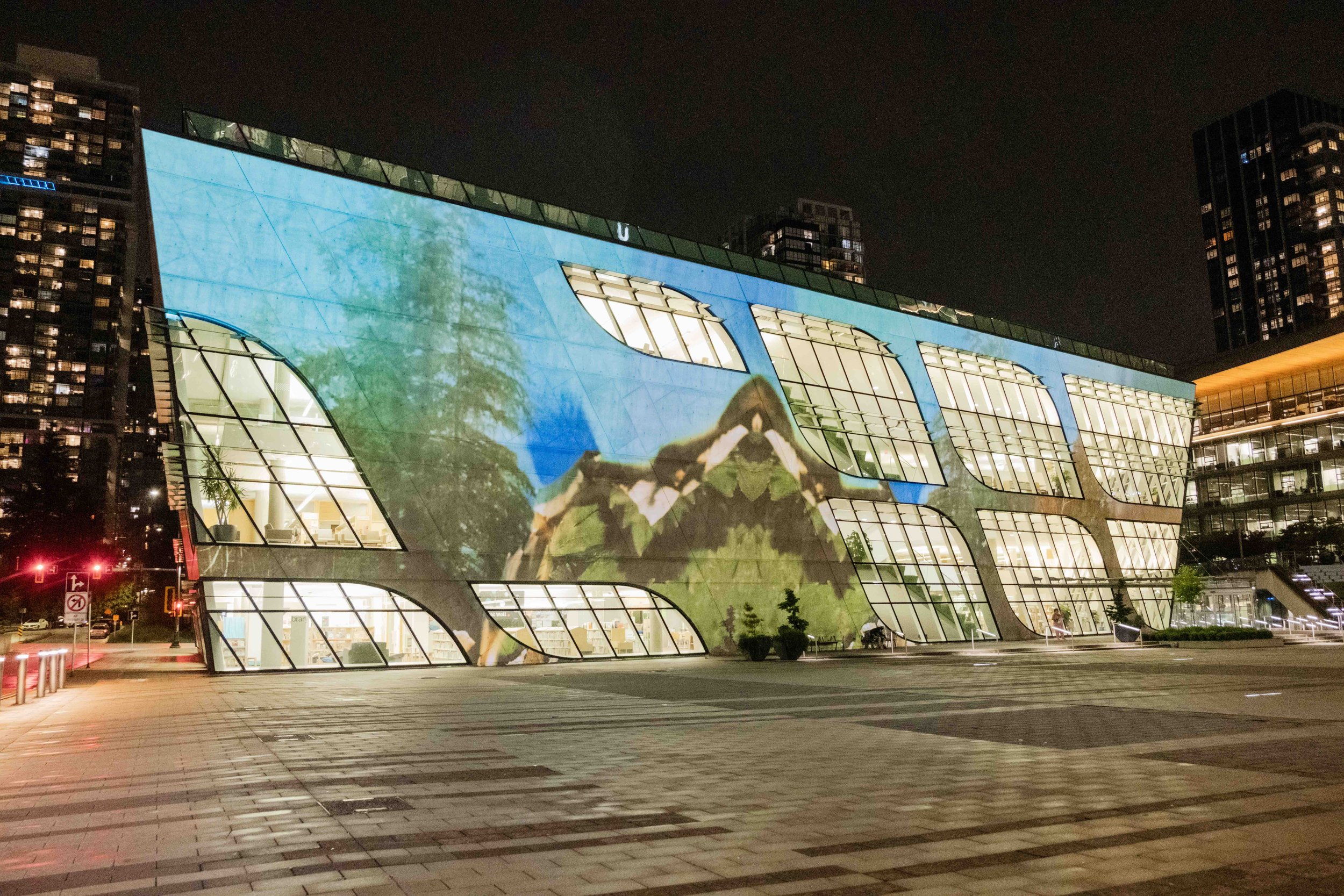At the Vancouver Art Gallery, The Imitation Game shows mind-expanding possibilities of AI meeting art and design
Robots “collaborate” with painters, while machines generate surreal visual worlds
Robots on wheels swirl paint around artist Sougwen Chung, in a video still from Omnia per Omnia. Courtesy of the Artist
The Vancouver Art Gallery presents The Imitation Game: Visual Culture in the Age of Artificial Intelligence to October 23
IT’S AS UNSETTLING as anything Philip K. Dick or Ursula K. Le Guin could have imagined.
On one screen, you can watch artist Stephanie Dinkins’s Conversations With Bin48, in which one of the world’s most advanced robots—complete with moving lips, lifelike skin, and blinking eyes—proceeds to explain to her human friend why there’s nothing “artificial” about artificial intelligence. On another, a generative adversarial network (GAN) tries to mimic digits, over hundreds of epochs, when its learning algorithms finally start to shape foggy blobs into recognizable numbers.
And just in case you needed reminding, there are clips of dystopian sci-fi flicks like Ex Machina and Space Odyssey 2001 to add to your fears.
Vancouver Art Gallery’s new exhibition The Imitation Game: Visual Culture in the Age of Artificial Intelligence features several AI experiments that are creepy and frightening. And yet as much as there is to terrify, there is also a lot to excite and fascinate in this show curated jointly by Bruce Grenville, senior curator at the VAG, and Glenn Entis, an animation pioneer, games-industry veteran, and founding faculty member for the Centre for Digital Media.
In a wide-ranging exhibition that took three years of planning, they track the explosive growth of AI across disciplines like architecture, animation, video games, fashion, and design.
And far from trying to scare us, Grenville says they’re attempting to build a “visual literacy” around AI—a technology that is already all around us, from automated investing to self-driving cars.
“The world really is changing,” Entis says during a tour of the show at the VAG. “The measure of success will be that people come away from this better equipped to learn more.
“A tsunami coming over us,” he adds, “and people don't know how to talk about it.”
Two major, room-filling installations—one devoted to the work of Sougwen Chung, and the other to artist Scott Eaton—reveal artificial intelligence’s beautiful, near-poetic possibilities in visual art.
Hong Kong-born, Canadian-raised, New York City-based Chung’s installation is full of fluid, blue-ink paintings that are collaborations between herself and her machines. On a video projection at one end, we see the artist, from a camera above, creating calligraphic loops and squiggles of ink across a sheet of paper, a massive, white robot arm reacting to her mark-making and adding its own complimentary flourishes to the painting. In the centre of the room is a collection of Roomba-sized robots—she calls them “Dougs”—that whiz around on wheels with their brushes trailing paint. In the works on the wall, it's impossible to separate the flowing abstract images that she’s created from the ones the computerized instrument has made.
Elsewhere, there’s a massive space devoted to the work of Eaton, whose unique skillset includes a master's degree from the MIT Media Lab, studies in drawing and sculpture in Florence, animation work with Disney and Pixar, and expertise in human anatomy. He has fed around 100,000 carefully photographed nudes into AI tools (his “Bodies neural network”) that he then directs to “paint” with those fleshy forms, melding and morphing them into photo-real, and often startlingly surreal, new imagery.
Scott Eaton, Entangled II, 2019, 4k video (still). Courtesy of the artist.
In his startling 4k video Entangled II, a mass of bulging flesh—a swirl of bellies, boobs, arms, and legs, but not quite human—“pours” like water down a huge vertical screen. But the big draw is Humanity (Fall of the Damned): from a distance, the backlit image looks like cascades of swaying tree moss; step closer, and it starts to resemble the sprawling Renaissance figures of the Sistine Chapel. But up close, the imagery is far more nightmarish. Uncountable nude figures tumble and intertwine as they fall into heaps. A reference to Ruben’s Fall of the Damned, it captures everything about human struggle at a time when “damnation” means climate disaster, pandemics, and war.
In the work of both Eaton and Chung, the creative possibilities of AI feel infinite and inspiring—a computer brain riffing and responding to human creation, imagining the unimaginable.
That endless creative potential is driven home elsewhere, too. Deep Dream continuously tweaks images; in one demonstration, it mutates a plate of green-bean tempura with lizard scales and machine parts. Artbreeder generates synthetic landscapes according to prompts: “House of the rising sun” or “The long and winding road” give way to vast, detailed dreamscapes. And sneakerheads will love the display of *airgans—limited-release, AI-generated sneakers that collate and combine details from couture, mass-market, and street-culture styles.
As Grenville puts it: “AI is providing models of creativity that didn't exist before."
There is more, much more. Grenville and Entis have formed a timeline of “20 Objects of Wonder” that trace the history of artificial intelligence all the way back to 1950. That’s when mathematician Alan Turing introduced the Turing test, or the “imitation game”, to judge a machine’s capacity to display intelligent behaviour that’s indistinguishable from human behaviour.
But as much as it tracks the past, The Imitation Game exhibit is about preparing us for the future. You may walk out of the gallery understanding, for the first time, how a generative adversarial network works, or—thanks in part to Chung or Eaton—with a vivid new picture of what machine learning actually looks like.
Armed with new information, you might not feel as afraid of, or unsettled, by the AI that is ready to take over our everyday lives. At the same time, gallery-goers may get a little more insight into humankind—to consider their own identity as data for AI.
“It’s all to enrich this conversation far outside the walls of the gallery,” Entis says of the exhibit. “The more you understand about AI, the more you understand about our own intelligence.”
For those who want to take a deeper dive into deep learning, the Vancouver Art Gallery is collaborating with UBC Humanities Hub to present the Speculative Futures Symposium around The Imitation Game exhibit. It takes place, virtually, of course, on April 7 from 10 am to 5 pm on Zoom. Attempting to address the ethical implications of AI technology and its application in cultural production, it features such speakers as Kings College's Dr. Ramon Amaro, UCLA and MacArthur Fellowship Honoree Dr. Safiya Umoja Noble, New Yorker writer Jiayang Fan, and UBC's Nalo Hopkinson. You can find more info here.















